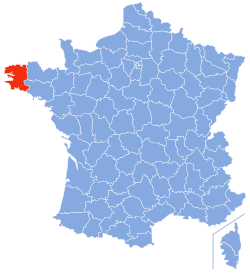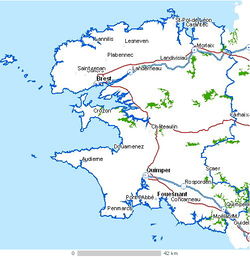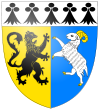Finistère
| Finistère | |||
|---|---|---|---|
| — Department — | |||
|
|||
 |
|||
| Coordinates: | |||
| Country | France | ||
| Region | Brittany | ||
| Prefecture | Quimper | ||
| Subprefectures | Brest Châteaulin Morlaix |
||
| Government | |||
| - President of the General Council | Pierre Maille (PS) | ||
| Area1 | |||
| - Total | 6,733 km2 (2,599.6 sq mi) | ||
| Population (2007)[1] | |||
| - Total | 886,500 | ||
| - Rank | 24th | ||
| - Density | 131.7/km2 (341/sq mi) | ||
| Time zone | CET (UTC+1) | ||
| - Summer (DST) | CEST (UTC+2) | ||
| Department number | 29 | ||
| Arrondissements | 4 | ||
| Cantons | 54 | ||
| Communes | 283 | ||
| ^1 French Land Register data, which exclude estuaries, and lakes, ponds, and glaciers larger than 1 km2 | |||
Finistère (Breton: Penn-ar-Bed) is a département of France, in the extreme west of Brittany.
Contents |
History
The name Finistère derives from the Latin Finis Terræ, meaning end of the earth, and may be compared with Land's End on the opposite side of the English Channel. Interestingly, the Breton Penn ar Bed translates as Head of the World.[2] Finistère is not to be confused with Cape Finisterre in Spain.
Geography
Finistère is the westernmost region of France (excluding the overseas departments).
The largest population center in Finistère is Brest. Other large towns in the département include Quimper (the prefecture or capital), Morlaix, Carhaix and Douarnenez. Finistère includes the island of Ushant (Eusa in Breton, Ouessant in French).

The abers, rugged fjord-like inlets on the north coast, are a notable feature of the landscape.
The westernmost point of continental France, known as the Pointe de Corsen, extends from the north-western tip of Finistère. A few miles to the south is the slightly less westerly, but rugged, & isolated, headland of Pointe du Raz.
Economy
Agriculture, food processing and various related industries occupy an important place in Finistère's economy.
The military presence in Finistère (Île Longue nuclear submarine base; Naval Air base of Lanvéoc-Poulmic), as well as military-related industries such as the Brest headquarters of DCNS employ a significant number of the département's population.
The port of Roscoff links Brittany by ferry with Ireland and Great Britain.
Culture
Finistère is the area where Breton survives most strongly as a spoken language. Breton-speaking schools are called Diwan, Divyezh and Dihun.
The Festival de Cornouaille, which takes place in Quimper, is a celebration of Breton music and traditions.
One of the highlights of summer in Finistère is the "Festival des Vieilles Charrues" held in Carhaix-Plouguer where major international stars attract tens of thousands of spectators. [1]
The painter Raymond Wintz (1884–1956) depicted many locations around Finistère.
Politics
The President of the General Council is Pierre Maille of the Socialist Party.
| Party | seats | |
|---|---|---|
| • | Socialist Party | 35 |
| Union for a Popular Movement | 10 | |
| • | Miscellaneous Left | 5 |
| Miscellaneous Right | 2 | |
| MoDem | 1 | |
| Centrist Alliance | 1 | |
See also
- Cantons of the Finistère department
- Communes of the Finistère department
- Arrondissements of the Finistère department
- Ys
References
- ↑ INSEE Finistere 2007. Retrieved 10 April 2009.
- ↑ Lonely Planet, Brittany. Retrieved 10 April 2009.
External links
- (French) General Council website
- (French) Prefecture website
- (English) Finistere at the Open Directory Project
- (French) http://www.finisteretourisme.com/
|
|||||
